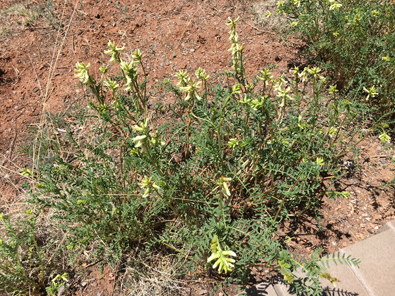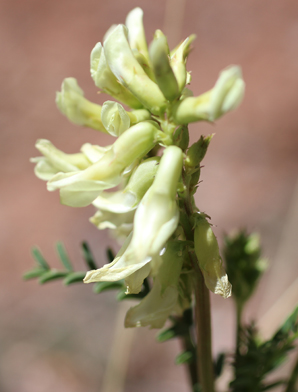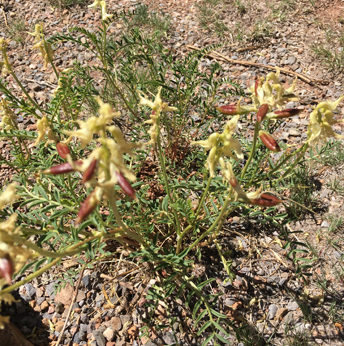
Location
Close to bridge #16 (N35D32'57.948 X W105D42'11.100)
Flowers first observed: 4/3/17
The Plant w/Flowers

The Flowers

The Flowers and Pods

Distribution
"S NV to c AZ, east to sw CO, NM, and w TX." (SEINet)
Description
"Astragalus praelongus variety lonchopus has long, tubular, light yellow flowers in thick dangling clusters. Last year's seed pods project in all directions. The long, narrow pods are compressed, usually straight but sometimes slightly curled, sharp-tipped, and on a long (4-8 millimeters) stipe (a stalk).
Stems are tall and light green and leaflets are numerous. The plant overall is quite robust and shrub-like with masses of flowers followed by masses of seed pods, many of which persist into the next growing season.
The plant often grows on Selenium rich soils and picks up the characteristic Selenium fetid odor, thus the common name, "Stinking Milkvetch". Beware! Touching this plant releases a really unpleasant Selenium stink. (See the very similar-stinking (but not similar looking) Astragalus pattersonii.)
This species was first collected for science by Edward Palmer in 1877 "Near St. Thomas, Nevada, at the confluence of the muddy River with the Virgen" and it was named Astragalus procerus by Asa Gray in 1878. Edmond Sheldon renamed it Astragalus praelongus in 1894. The Latin "prae, longus", means "very, long" and refers to the flower length and plant height." (SW Colorado Wildflowers)
Ethnobotanical Uses
"Ramah Navajo used it as a ceremonial emetic." (SEINet)
Internet Links